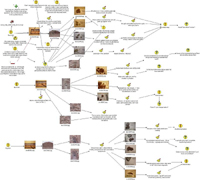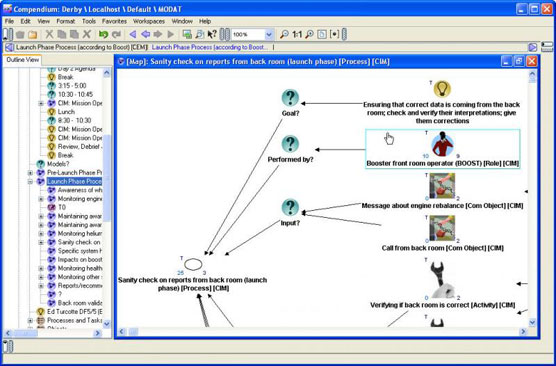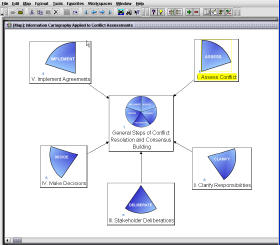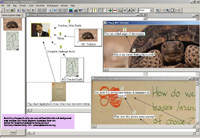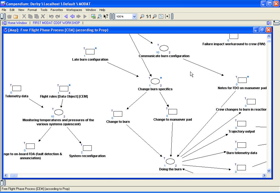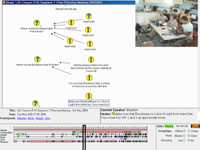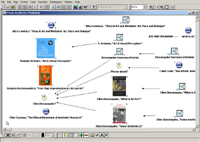2006
Compendium Overview
Slides: [10Mb PPT] [5.5Mb PDF]
Presented at Computational Semantics Laboratory, Stanford University
September 2006
Maarten Sierhuis
From gIBIS to MEMETIC: Evolving a Research Vision into a Practical Tool
Slides: [17.6Mb PPT] [7.5Mb PDF]
Presented at Design Rationale Workshop: Design, Computing & Cognition Conference, Eindhoven
July 2006
Simon Buckingham Shum, Albert M. Selvin, Maarten Sierhuis, Jeff Conklin, Mike Daw, Andrew Rowley, Ben Juby, Danius Michaelides, Roger Slack, Michelle Bachler, Clara Mancini, Rob Procter, David de Roure, Tim Chown, Terry Hewitt
A Brief History of Compendium (in Compendium map format)
Theoretical Perspectives on Compendium (in Compendium map format)
Presented at Compendium Workshop, Semaine da la Connaissance, Nantes, France
30 June 2006
Albert M. Selvin
Co-OPR: Design and Evaluation of Collaborative Sensemaking and Planning Tools for Personnel Recovery
Knowledge Media Institute Technical Report KMI-06-07
May 2006
Austin Tate, Simon Buckingham Shum, Jeff Dalton, Clara Mancini, Albert M. Selvin
2005
Dialogue Mapping: Building Shared Understanding of Wicked Problems
John Wiley & Sons, ISBN: 0-470-01768-6
Jeff Conklin
Compendium Institute 2005 Workshop
Held at Touchstone Consulting, Washington DC
10-11 November 2005
Aesthetic and Ethical Implications of Participatory Hypermedia Practice: First Year Report
Technical Report KM-05-17, Knowledge Media Institute, Open University, UK
November 2005
Albert M. Selvin
Hypermedia Support for Argumentation-Based Rationale: 15 Years on from gIBIS and QOC
PrePrint of chapter to appear in: Rationale Management in Software Engineering, (Eds.) Allen H. Dutoit, Raymond McCall, Ivan Mistrik, and Barbara Paech
Springer-Verlag/Computer Science Editorial (2006)
Simon J. Buckingham Shum, Albert M. Selvin, Maarten Sierhuis, Jeffrey Conklin, Charles B. Haley and Bashar Nuseibeh
Hypermedia as a Productivity Tool for Doctoral Research
PrePrint of article appearing in New Review of Hypermedia and Multimedia
Volume 11 issue 1 pp. 91-101
June 2005
Albert M. Selvin and Simon Buckingham Shum
Making Knowledge Art: Learning from the Improvisatory Dynamics of Live Participatory Hypermedia
Workshop presented at PARIP 2005 International Conference, Bretton Hall, West Yorkshire UK
29 June – 03 July 2005
Albert M. Selvin and Simon Buckingham Shum
2004
Human and Robot Exploration on Mars or Moon
(webcast seminar) Knowledge Media Institute, Open University, UK.
Maarten Sierhuis
The Mobile Agents Architecture Supporting Science Extra-Vehicular Activities on Planetary Surfaces
Mars Society
Maarten Sierhuis
Experiment B Report for Co-OPR: Collaborative Operations for Personnel Recovery
Austin Tate, Jeff Dalton, Simon Buckingham Shum, Clara Mancini, Albert M. Selvin
Other materials available here.
Facilitating Remote Science Teams (presentation)
Mars Society Conference, Chicago, IL
August 2004
Albert M. Selvin and Simon Buckingham Shum
Building Collaborative Knowledge Representations in Real Time: An Analysis of Facilitative Micro-Actions (webcast seminar)
Knowledge Media Institute, Open University, UK
5 October 2004
Albert M. Selvin
2003
Ontological Mediation of Meeting Structure: Argumentation, Annotation, and Navigation
1st International Workshop on Hypermedia and the Semantic Web
Nottingham, UK
30 August 2003
Michelle Bachler, Simon Buckingham Shum, David De Roure, Danius Michaelides, and Kevin Page
Facilitated Hypertext for Collective Sensemaking: 15 Years on from gIBIS
Keynote Address, Proceedings LAP’03: 8th International Working Conference on the Language-Action Perspective on Communication Modelling
H. Weigand, G. Goldkuhl and A. de Moor (Eds.)
Tilburg, The Netherlands
1-2 July 2003
Jeff Conklin, Albert M. Selvin, Simon Buckingham Shum, and Maarten Sierhuis
Exploration for Development: Developing Leadership by Making Shared Sense of Complex Challenges
Consulting Psychology Journal, 55 (1), 26-40
Charles J. Palus, David Horth, Mary Lynn Pully, and Albert M. Selvin
Practising Knowledge Art (presentation)
Knowledge Media Institute, Berrill Building, The Open University, Milton Keynes, United Kingdom
22 May 2003
Albert M. Selvin
Sensemaking Techniques in Support of Leadership Development
Knowledge Management, 7(1)
Inside Knowledge Magazine
Albert M. Selvin and Charles J. Palus
2002
Fostering Collective Intelligence: Helping Groups Use Visualized Argumentation Albert M. Selvin
Dialog Mapping: Reflections on an Industrial Strength Case Study
Jeff Conklin
Visualizing Argumentation: Software Tools for Collaborative and Educational Sense-Making
Paul A. Kirschner, Simon J. Buckingham Shum and Chad S. Carr (Eds.), Springer-Verlag: London, 2002.
ISBN 1-85233-6641-1
Knowledge Art: Visual Sensemaking Using Combined Compendium and Visual Explorer Methodologies
Presented to: The Art of Management and Organisation Conference
Essex Management Centre, University of Essex, at King’s College London
3-6 September 2002
Albert M. Selvin, Simon J. Buckingham, David Magellan Horth, Charles J. Palus, Maarten Sierhuis
CoAKTinG: Collaborative Advanced Knowledge Technologies in the Grid
in Proc. Second Workshop on Advanced Collaborative Environments
Eleventh IEEE Int. Symposium on High Performance Distributed Computing (HPDC-11)
July 24-26, 2002, Edinburgh
Simon Buckingham Shum, David De Roure, Marc Eisenstadt, Nigel Shadbolt, Austin Tate
Knowledge Art: Integrating Compendium and Visual Explorer Methodologies to Explore Creative Sensemaking
pp 6-11 in: P Galle and G E Lasker (Eds.)
Knowledge for Creative Decision-Making
Proceedings of a Special Focus Symposium under InterSymp-2002 in Baden-Baden, Germany
Windsor, Ontario: The International Institute for Advanced Studies in Systems Research & Cybernetics. ISBN 1-894613-79-1
Not currently available online
Albert M. Selvin, Charles J. Palus, Maarten Sierhuis
Report and Papers from Facilitating Hypertext-Augmented Collaborative Modeling (HypACoM) Workshop
Held at ACM Hypertext 2002 Conference, College Park, MD, USA
11 June 2002
Augmenting Design Deliberation with Compendium: The Case of Collaborative Ontology Design
Simon Buckingham Shum, Enrico Motta, John Domingue
Reflections on Artful Practice: Compendium in the Context of Leadership Development
Charles J. Palus
Hypertext Shared Display as Collaborative Modeling
Kim Salins (with Jeff Conklin)
Rearchitecting a Software Platform: A Beginner’s Case Study with Dialog Mapping
Eugene Eric Kim
Reflections on HACM Facilitation
Albert M. Selvin
Rapid Knowledge Construction: A Case Study in Corporate Contingency Planning Using Collaborative Hypermedia
Published Online: April 16, 2002
Online ISSN: 1099-1441; Print ISSN: 1092-4604
Journal of Knowledge and Process Management
Volume 9, Issue 2, 2002. Pages: 119-128
Albert M. Selvin and Simon Buckingham Shum
2001
Sense-Making and Knowledge Collaboration Tools
11 September 2001
Jeff Conklin
Facilitated Hypertext for Collective Sensemaking: 15 Years on from gIBIS
TR Number 112
19 September 2001
Jeff Conklin, Albert M. Selvin, Simon Buckingham Shum and Maarten Sierhuis
PDF: http://kmi.open.ac.uk/tr/papers/kmi-tr-112.pdf
Compendium: Making Meetings into Knowledge Events
Knowledge Technologies 2001, Austin TX
4-7 March 2001
Albert M. Selvin, Simon Buckingham Shum, Maarten Sierhuis, Jeff Conklin, Beatrix Zimmermann, Charles J. Palus, Wilfred Drath, David Horth, John Domingue, Enrico Motta, and G. Li
2000
Structuring Discourse for Collective Interpretation
DCP2000: Distributed Collective Practices 2000
Ecole Nationale Supérieure des Télécommunications, Paris, France
19-20 September 2000
Simon J. Buckingham Shum and Albert M. Selvin
Rapid Knowledge Construction: A Case Study in Corporate Contingency Planning Using Collaborative Hypermedia
KMaC 2000: Knowledge Management Beyond the Hype.
Aston Business School, Aston University, Birmingham, UK
16-19 July 2000
Albert M. Selvin and Simon J. Buckingham Shum
1999
Case Studies of Project Compendium in Different Organizations
Argumentation in Different CSCA Project Types
Workshop on Computer-Supported Collaborative Argumentation for Learning Communities, CSCL ’99
Stanford University
December 1999
Albert M. Selvin and Maarten Sierhuis
Supporting Collaborative Analysis and Design with Hypertext Functionality
Journal of Digital Information
Volume 1 Issue 4, Article No. 16, 1999-01-14
Albert M. Selvin
Repurposing Requirements: Improving Collaborative Sense-Making over the Lifecycle
Note: This will download the whole proceedings of the Profes conference. The paper is on page 539.
International Conference on Product-Focused Software Process Improvement
(Profes ’99) Oulu, Finland
Albert M. Selvin and Simon Buckingham Shum
Collaborative Sense-Making in Design:
Involving Stakeholders via Representational Morphing
Open University – Knowledge Media Institute Technical Report KMI-99-1
Simon Buckingham Shum and Albert M. Selvin
Reforging the Links: QuestMap, Project Compendium and First Class
Rebekah L. Irwin
Using World Modeling Interviews to Develop Lists of Shared Problems, Opportunities, Know-how and Assets Shared by Wisconsin Public Television and the U.W. System Learning Innovations Center
Steven Vedro
Reforging the Links: The University Digital Business Partnership Project
1998
Supporting Granular Reuse of Knowledge Elements in an Organizational Memory System
Seventh International Workshop on Hypertext Functionality in Information Systems (ICIS ’98)
Helsinki, Finland
Albert M. Selvin
1997
A Framework for Assessing Group Memory Approaches for Software Design Projects
Proceedings of the Conference on Designing Interactive Systems (DIS 1997)
The Netherlands
Beatrix Zimmermann and Albert M. Selvin
Towards an Ecological Theory of Sustainable Knowledge Networks
Touchstone Consulting Group, Inc. Working Papers
Jeff Conklin, Clarence Ellis, Lynn Offermann, Steve Poltrock, Albert Selvin, and Jonathan Grudin
1996
Leveraging Existing Hypertext Functionality to Create A Customized Environment for Team Analysis
Second International Workshop on Hypertext Functionality in Information Systems (Hypertext ’96)
Bethesda, Maryland
Albert M. Selvin
Towards a Framework for Collaborative Modeling and Simulation
Position paper for Workshop on Strategies for Collaborative Modeling and Simulation
Conference on Computer-Supported Collaborative Work
Boston, MA, 1996
Maarten Sierhuis and Albert M. Selvin
Read more
